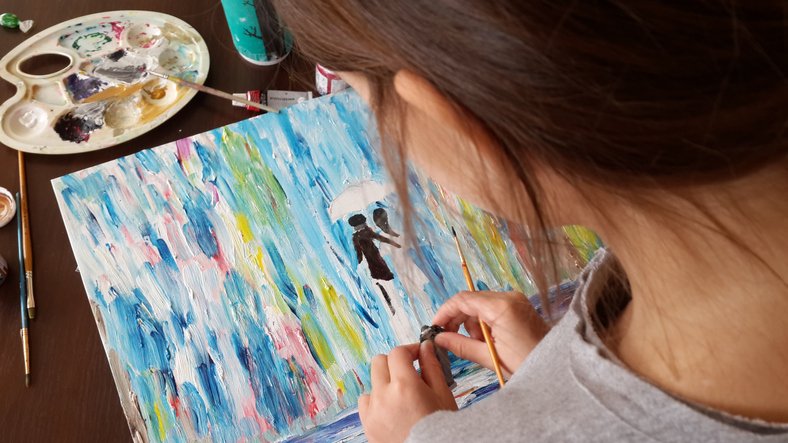“Through art, the students were able to communicate what they felt and how they lived the pandemic.”
The COVID-19 pandemic forced students out of face-to-face classrooms. This event brought with it fear, uncertainty, and a sense of loneliness from the confinement. It was a drastic change for the emotional and physical stability of the adolescents. Therefore, we as teachers had to look for alternatives for students to continue their academic training while they needed to channel their anxiety and stress caused by the pandemic. In my art class, I integrated activities for the students to create artistic works to ensure their emotional health. In these exercises, the students expressed their feelings, emotions, and hobbies without neglecting the objective of the subject being taught.
Applying art and creativity in new school projects helps students understand their reality from different perspectives. According to Lehrer (cited by Vommaro 2014), art can be expressed in various forms like music, dance, drawing, painting, sculpture, and literature; any of these variants involves the notion of creativity. This point was crucial for the students to develop their class projects during the contingency; it helped them communicate what they felt and how they lived the pandemic. Learning art must center around projects, which give rise to reflection, motivation, and creativity (Ripoll, 2018).
“In their projects, they showed their knowledge learned about art, their feelings, and hobbies, as well as their artistic production.”
Virtual exhibition of contemporary art
The students of PrepaTec, Campus Morelia, created artistic works to express their emotions and hobbies in a virtual contemporary art exhibition. The activity was carried out for the online Applied Art and Humanities Project in the August 2020-May 2021 school year. We aimed for students to develop specific competencies such as assertive communication, teamwork, and self-management through this subject.
The artworks created by the students were exhibited virtually using platforms such as People Art Factory, Artsteps, and Kunstmatrix. These are sites specialized in the elaboration of 3D museum-type exhibitions. Once the students’ exhibitions were finished, they were shared on the school’s social networks so that the community, parents, and the general public could appreciate the work done by the students.
Below are the digital exhibitions made by five teams in the class:
-
“Adversity and the Universe.” Our reality is surrounded by happenings that exceed what humanity manages to understand and control, for example, nature, the pandemic, and the universe. Although certain events have been studied, we do not know with certainty how they arose. This exhibition explores these themes from the perspective of art and reflection.
-
“Divergence.” Each mind is a beautiful and unique world. In these works, you will discover each artist’s different ways of thinking and expressing their ideas.
-
“Longings.” Growing up is inevitable, but childhood memories will always be the most precious. This exhibition will make you relive your best childhood moments through art and creativity.
-
“Introspective of the Artist’s Mind.” The works of two Mexican artists are exhibited, one from Michoacan and the other Veracruz. Through their works, we glimpse everything revolving around in their minds. We can observe different aspects of their personalities and the distinctive elements that make them who they are.
-
“The Taste of Feelings.” In this exhibition, the artists share experiences that marked them with feelings, moments, and ideas they embody in photographs and canvases, and paper. The artists seek to communicate the feelings of love or sadness for someone, something, or some memory, to which the viewer connects.
Production of artistic works in class: description of the activity
This project was developed over a year in two stages, one semester each. In the first stage, 18 fifth-semester students participated and 29 sixth-semester students in the second. The activities elaborated in each stage are described below.
Stage 1
This project begins during the fifth semester of high school. Students work individually from home, producing three types of art in painting, photography, video art, collage, or sculpture media. Due to the confinement, the students used resources at their disposal to create their works. To help them achieve this, I explained the main concepts of art, artistic movements, and new manifestations of art during the first part.
By the second part, the students had already produced 54 works of art. Therefore, local artists were invited to talk to the students virtually about their creative process and show them their works to strengthen the theory of artistic production.
For the third part, the students continued to work individually on creating their technical sheets and the artistic declaration of their works annexed to their portfolios. They had to explain the reason for each production and what it meant to them, and the technique used.
Stage 2
In this stage, 29 new students were integrated during the sixth semester, and the others no longer took the subject. The aim was to organize an exhibition of contemporary art with the works produced in the previous semester. However, some students decided to create new works to add to the virtual art exhibition because they did not want to miss the opportunity to convey their emotions and hobbies. The new artists were integrated. The class was divided into five teams.
We reviewed helpful topics to organize an exhibition, including introducing artistic exhibitions, museography, and curatorship. Because the Covid-19 health contingency continued, we chose to be virtual. So, the students began to investigate the platforms to create the virtual exhibition.
According to Jamil Samil, an international expert in the development of higher education systems, “The challenge of online education is to promote the feeling of belonging so that students do not feel isolated and are involved in the activities with the teacher and their peers” (Cortés, 2020). Therefore, we decided to form student work teams for collaboration on a joint project to transmit
a single idea. It strengthens teamwork, cooperation, and a sense of belonging within the exhibition.
Reflection
From their homes, the students could convey what they were thinking and feeling and share their hobbies; the subject’s objective was fulfilled in the course. With this project, the students were able to show their artistic works and the knowledge they acquired about art and artistic production. However, the essential thing they cited at the end of the course was developing emotionally and growing as people.
This project had a national impact because from the five teams, the one that created the exhibition called “Introspective of the Artist’s Mind” participated in the First Virtual Festival of Arts and Humanities Electives. It was organized for the PrepaTec high schools throughout the nation (affiliated with the Tecnologico de Monterrey campuses) by its Social Sciences, Humanities, and Languages departments. In the exposition, the students’ art showed the emotions and thoughts revolving in their minds.
About the Author
Judith Pérez Arceo (judithperez@tec.mx) is a Communicologist. She has a master’s degree in Education with a specialty in Upper Secondary Education. She is a full-time teacher in Spanish at PrepaTec on the Tecnologico de Monterrey Morelia campus. She has over 15 years of experience teaching, conducting workshops, and editing for an educational company.
References
Cortés, P. (2021). Pandemia mostró importancia de la educación en línea: Jamil Samil. Universo. Accessed at: https://www.uv.mx/prensa/general/pandemia-mostro-importancia-de-la-educacion-en-linea-jamil-samil/
Ripoll, M. (2018). Adolescencia y las emociones representadas a través del arte. Polytechnic University of Valencia Congress.
Vommaro, H. (2014). El arte como expresión emocional, no verbal. Accessed at: https://www.lavoz.com.ar/salud/el-arte-como-expresion-emocional-no-verbal/
Edited by Rubí Román (rubi.roman@tec.mx) – Observatory of Educational Innovation.
Translation by Daniel Wetta.
This article from Observatory of the Institute for the Future of Education may be shared under the terms of the license CC BY-NC-SA 4.0 
)
)


)